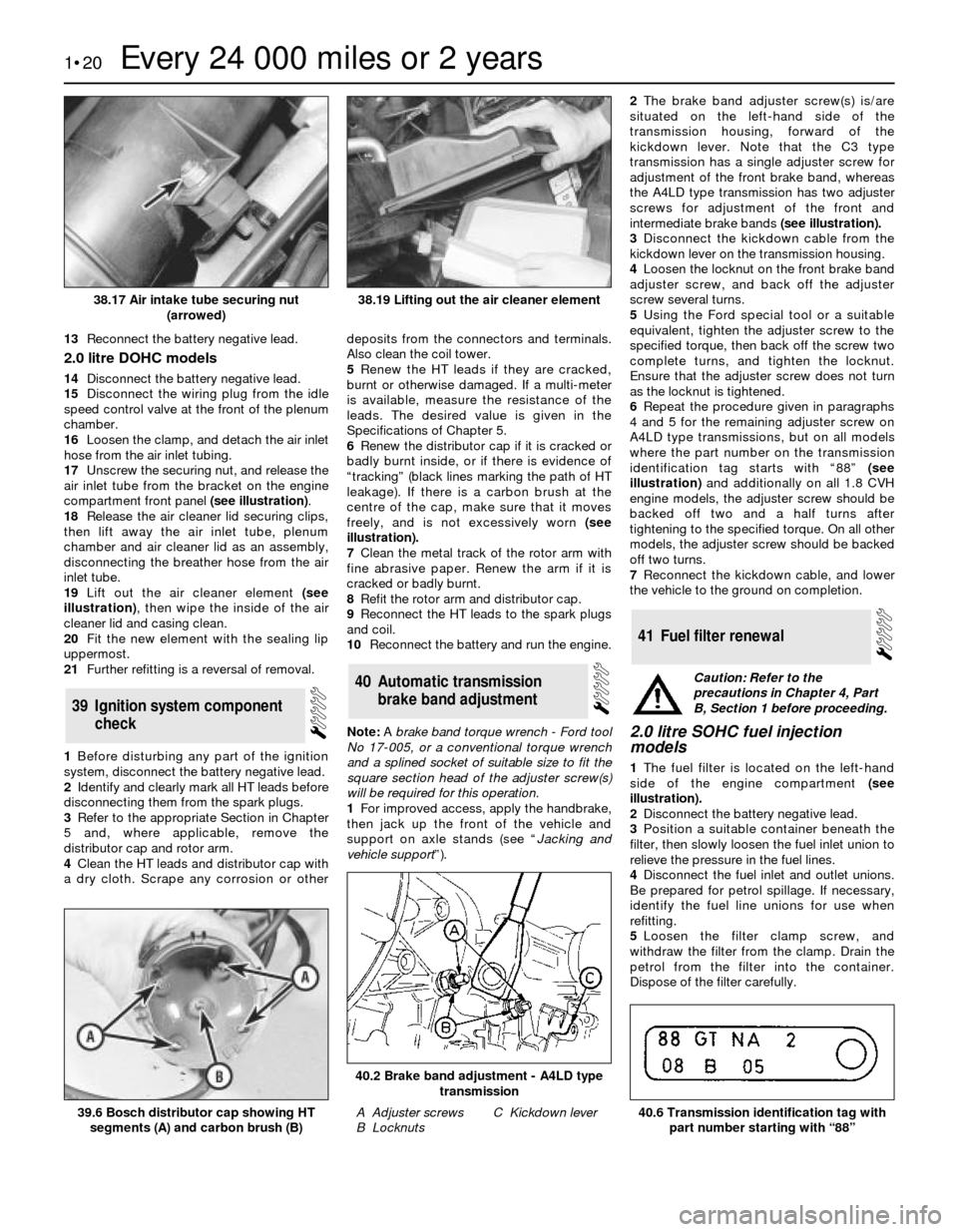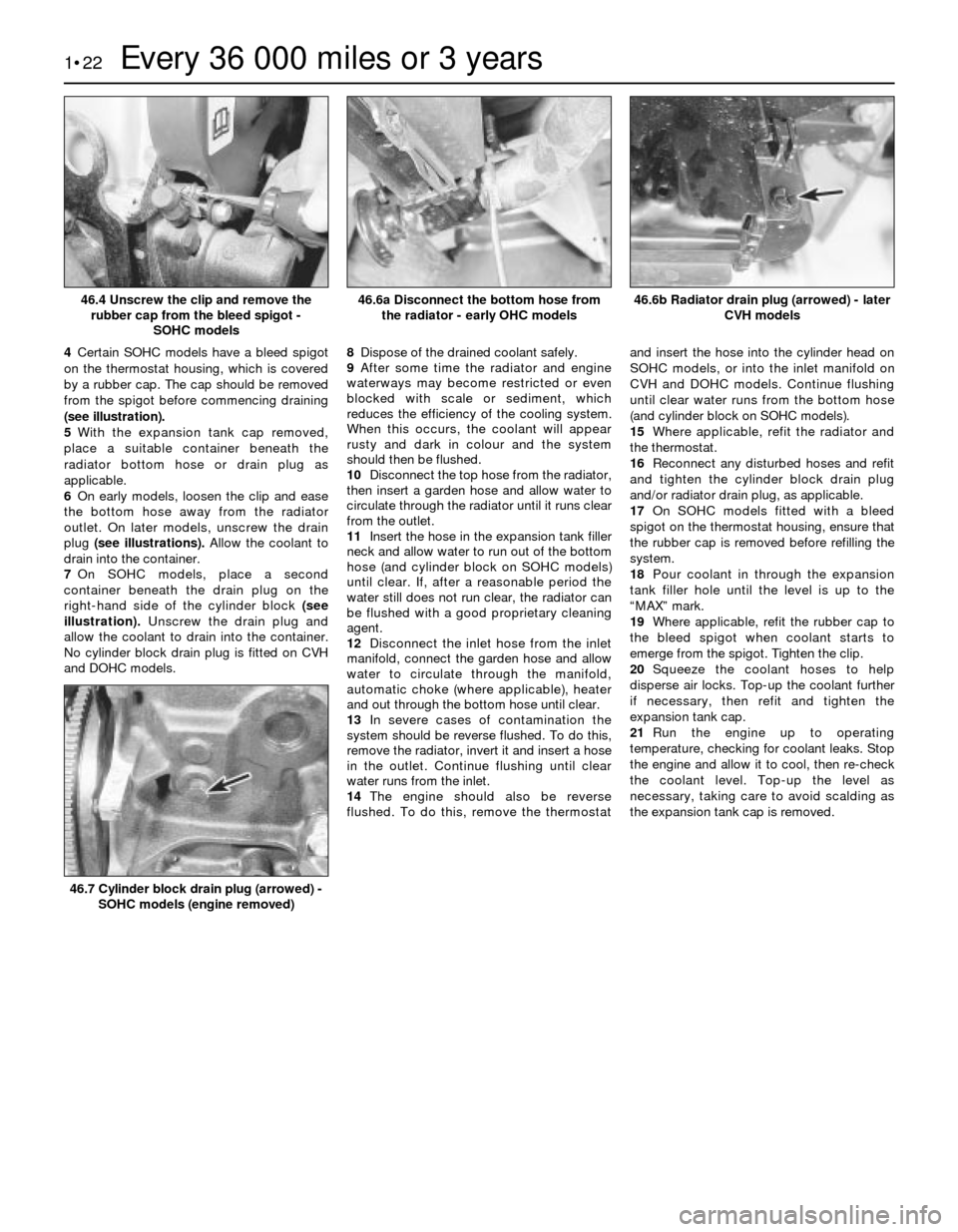lock FORD SIERRA 1988 2.G Routine Manintenance And Servicing User Guide
[x] Cancel search | Manufacturer: FORD, Model Year: 1988, Model line: SIERRA, Model: FORD SIERRA 1988 2.GPages: 22, PDF Size: 1.26 MB
Page 20 of 22

13Reconnect the battery negative lead.
2.0 litre DOHC models
14Disconnect the battery negative lead.
15Disconnect the wiring plug from the idle
speed control valve at the front of the plenum
chamber.
16Loosen the clamp, and detach the air inlet
hose from the air inlet tubing.
17Unscrew the securing nut, and release the
air inlet tube from the bracket on the engine
compartment front panel (see illustration).
18Release the air cleaner lid securing clips,
then lift away the air inlet tube, plenum
chamber and air cleaner lid as an assembly,
disconnecting the breather hose from the air
inlet tube.
19Lift out the air cleaner element (see
illustration), then wipe the inside of the air
cleaner lid and casing clean.
20Fit the new element with the sealing lip
uppermost.
21Further refitting is a reversal of removal.
1Before disturbing any part of the ignition
system, disconnect the battery negative lead.
2Identify and clearly mark all HT leads before
disconnecting them from the spark plugs.
3Refer to the appropriate Section in Chapter
5 and, where applicable, remove the
distributor cap and rotor arm.
4Clean the HT leads and distributor cap with
a dry cloth. Scrape any corrosion or otherdeposits from the connectors and terminals.
Also clean the coil tower.
5Renew the HT leads if they are cracked,
burnt or otherwise damaged. If a multi-meter
is available, measure the resistance of the
leads. The desired value is given in the
Specifications of Chapter 5.
6Renew the distributor cap if it is cracked or
badly burnt inside, or if there is evidence of
“tracking” (black lines marking the path of HT
leakage). If there is a carbon brush at the
centre of the cap, make sure that it moves
freely, and is not excessively worn (see
illustration).
7Clean the metal track of the rotor arm with
fine abrasive paper. Renew the arm if it is
cracked or badly burnt.
8Refit the rotor arm and distributor cap.
9Reconnect the HT leads to the spark plugs
and coil.
10Reconnect the battery and run the engine.
Note: A brake band torque wrench - Ford tool
No 17-005, or a conventional torque wrench
and a splined socket of suitable size to fit the
square section head of the adjuster screw(s)
will be required for this operation.
1For improved access, apply the handbrake,
then jack up the front of the vehicle and
support on axle stands (see “Jacking and
vehicle support”).2The brake band adjuster screw(s) is/are
situated on the left-hand side of the
transmission housing, forward of the
kickdown lever. Note that the C3 type
transmission has a single adjuster screw for
adjustment of the front brake band, whereas
the A4LD type transmission has two adjuster
screws for adjustment of the front and
intermediate brake bands(see illustration).
3Disconnect the kickdown cable from the
kickdown lever on the transmission housing.
4Loosen the locknut on the front brake band
adjuster screw, and back off the adjuster
screw several turns.
5Using the Ford special tool or a suitable
equivalent, tighten the adjuster screw to the
specified torque, then back off the screw two
complete turns, and tighten the locknut.
Ensure that the adjuster screw does not turn
as the locknut is tightened.
6Repeat the procedure given in paragraphs
4 and 5 for the remaining adjuster screw on
A4LD type transmissions, but on all models
where the part number on the transmission
identification tag starts with “88”(see
illustration)and additionally on all 1.8 CVH
engine models, the adjuster screw should be
backed off two and a half turns after
tightening to the specified torque. On all other
models, the adjuster screw should be backed
off two turns.
7Reconnect the kickdown cable, and lower
the vehicle to the ground on completion.
2.0 litre SOHC fuel injection
models
1The fuel filter is located on the left-hand
side of the engine compartment(see
illustration).
2Disconnect the battery negative lead.
3Position a suitable container beneath the
filter, then slowly loosen the fuel inlet union to
relieve the pressure in the fuel lines.
4Disconnect the fuel inlet and outlet unions.
Be prepared for petrol spillage. If necessary,
identify the fuel line unions for use when
refitting.
5Loosen the filter clamp screw, and
withdraw the filter from the clamp. Drain the
petrol from the filter into the container.
Dispose of the filter carefully.
41Fuel filter renewal
40Automatic transmission
brake band adjustment
39Ignition system component
check
1•20Every 24 000 miles or 2 years
38.17 Air intake tube securing nut
(arrowed)
39.6 Bosch distributor cap showing HT
segments (A) and carbon brush (B)40.6 Transmission identification tag with
part number starting with “88”
40.2 Brake band adjustment - A4LD type
transmission
A Adjuster screws
B LocknutsC Kickdown lever
38.19 Lifting out the air cleaner element
Caution: Refer to the
precautions in Chapter 4, Part
B, Section 1 before proceeding.
Page 22 of 22

4Certain SOHC models have a bleed spigot
on the thermostat housing, which is covered
by a rubber cap. The cap should be removed
from the spigot before commencing draining
(see illustration).
5With the expansion tank cap removed,
place a suitable container beneath the
radiator bottom hose or drain plug as
applicable.
6On early models, loosen the clip and ease
the bottom hose away from the radiator
outlet. On later models, unscrew the drain
plug (see illustrations).Allow the coolant to
drain into the container.
7On SOHC models, place a second
container beneath the drain plug on the
right-hand side of the cylinder block (see
illustration).Unscrew the drain plug and
allow the coolant to drain into the container.
No cylinder block drain plug is fitted on CVH
and DOHC models.8Dispose of the drained coolant safely.
9After some time the radiator and engine
waterways may become restricted or even
blocked with scale or sediment, which
reduces the efficiency of the cooling system.
When this occurs, the coolant will appear
rusty and dark in colour and the system
should then be flushed.
10Disconnect the top hose from the radiator,
then insert a garden hose and allow water to
circulate through the radiator until it runs clear
from the outlet.
11Insert the hose in the expansion tank filler
neck and allow water to run out of the bottom
hose (and cylinder block on SOHC models)
until clear. If, after a reasonable period the
water still does not run clear, the radiator can
be flushed with a good proprietary cleaning
agent.
12Disconnect the inlet hose from the inlet
manifold, connect the garden hose and allow
water to circulate through the manifold,
automatic choke (where applicable), heater
and out through the bottom hose until clear.
13In severe cases of contamination the
system should be reverse flushed. To do this,
remove the radiator, invert it and insert a hose
in the outlet. Continue flushing until clear
water runs from the inlet.
14The engine should also be reverse
flushed. To do this, remove the thermostatand insert the hose into the cylinder head on
SOHC models, or into the inlet manifold on
CVH and DOHC models. Continue flushing
until clear water runs from the bottom hose
(and cylinder block on SOHC models).
15Where applicable, refit the radiator and
the thermostat.
16Reconnect any disturbed hoses and refit
and tighten the cylinder block drain plug
and/or radiator drain plug, as applicable.
17On SOHC models fitted with a bleed
spigot on the thermostat housing, ensure that
the rubber cap is removed before refilling the
system.
18Pour coolant in through the expansion
tank filler hole until the level is up to the
“MAX” mark.
19Where applicable, refit the rubber cap to
the bleed spigot when coolant starts to
emerge from the spigot. Tighten the clip.
20Squeeze the coolant hoses to help
disperse air locks. Top-up the coolant further
if necessary, then refit and tighten the
expansion tank cap.
21Run the engine up to operating
temperature, checking for coolant leaks. Stop
the engine and allow it to cool, then re-check
the coolant level. Top-up the level as
necessary, taking care to avoid scalding as
the expansion tank cap is removed.
1•22Every 36 000 miles or 3 years
46.4 Unscrew the clip and remove the
rubber cap from the bleed spigot -
SOHC models46.6b Radiator drain plug (arrowed) - later
CVH models
46.7 Cylinder block drain plug (arrowed) -
SOHC models (engine removed)
46.6a Disconnect the bottom hose from
the radiator - early OHC models